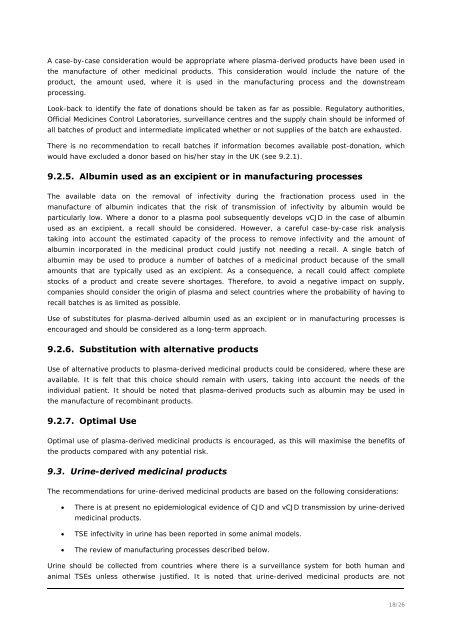CHMP position statement on Creutzfeldt-Jakob disease and plasma ...
CHMP position statement on Creutzfeldt-Jakob disease and plasma ...
CHMP position statement on Creutzfeldt-Jakob disease and plasma ...
Create successful ePaper yourself
Turn your PDF publications into a flip-book with our unique Google optimized e-Paper software.
A case-by-case c<strong>on</strong>siderati<strong>on</strong> would be appropriate where <strong>plasma</strong>-derived products have been used in<br />
the manufacture of other medicinal products. This c<strong>on</strong>siderati<strong>on</strong> would include the nature of the<br />
product, the amount used, where it is used in the manufacturing process <strong>and</strong> the downstream<br />
processing.<br />
Look-back to identify the fate of d<strong>on</strong>ati<strong>on</strong>s should be taken as far as possible. Regulatory authorities,<br />
Official Medicines C<strong>on</strong>trol Laboratories, surveillance centres <strong>and</strong> the supply chain should be informed of<br />
all batches of product <strong>and</strong> intermediate implicated whether or not supplies of the batch are exhausted.<br />
There is no recommendati<strong>on</strong> to recall batches if informati<strong>on</strong> becomes available post-d<strong>on</strong>ati<strong>on</strong>, which<br />
would have excluded a d<strong>on</strong>or based <strong>on</strong> his/her stay in the UK (see 9.2.1).<br />
9.2.5. Albumin used as an excipient or in manufacturing processes<br />
The available data <strong>on</strong> the removal of infectivity during the fracti<strong>on</strong>ati<strong>on</strong> process used in the<br />
manufacture of albumin indicates that the risk of transmissi<strong>on</strong> of infectivity by albumin would be<br />
particularly low. Where a d<strong>on</strong>or to a <strong>plasma</strong> pool subsequently develops vCJD in the case of albumin<br />
used as an excipient, a recall should be c<strong>on</strong>sidered. However, a careful case-by-case risk analysis<br />
taking into account the estimated capacity of the process to remove infectivity <strong>and</strong> the amount of<br />
albumin incorporated in the medicinal product could justify not needing a recall. A single batch of<br />
albumin may be used to produce a number of batches of a medicinal product because of the small<br />
amounts that are typically used as an excipient. As a c<strong>on</strong>sequence, a recall could affect complete<br />
stocks of a product <strong>and</strong> create severe shortages. Therefore, to avoid a negative impact <strong>on</strong> supply,<br />
companies should c<strong>on</strong>sider the origin of <strong>plasma</strong> <strong>and</strong> select countries where the probability of having to<br />
recall batches is as limited as possible.<br />
Use of substitutes for <strong>plasma</strong>-derived albumin used as an excipient or in manufacturing processes is<br />
encouraged <strong>and</strong> should be c<strong>on</strong>sidered as a l<strong>on</strong>g-term approach.<br />
9.2.6. Substituti<strong>on</strong> with alternative products<br />
Use of alternative products to <strong>plasma</strong>-derived medicinal products could be c<strong>on</strong>sidered, where these are<br />
available. It is felt that this choice should remain with users, taking into account the needs of the<br />
individual patient. It should be noted that <strong>plasma</strong>-derived products such as albumin may be used in<br />
the manufacture of recombinant products.<br />
9.2.7. Optimal Use<br />
Optimal use of <strong>plasma</strong>-derived medicinal products is encouraged, as this will maximise the benefits of<br />
the products compared with any potential risk.<br />
9.3. Urine-derived medicinal products<br />
The recommendati<strong>on</strong>s for urine-derived medicinal products are based <strong>on</strong> the following c<strong>on</strong>siderati<strong>on</strong>s:<br />
� There is at present no epidemiological evidence of CJD <strong>and</strong> vCJD transmissi<strong>on</strong> by urine-derived<br />
medicinal products.<br />
� TSE infectivity in urine has been reported in some animal models.<br />
� The review of manufacturing processes described below.<br />
Urine should be collected from countries where there is a surveillance system for both human <strong>and</strong><br />
animal TSEs unless otherwise justified. It is noted that urine-derived medicinal products are not<br />
18/26


